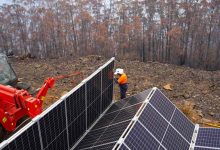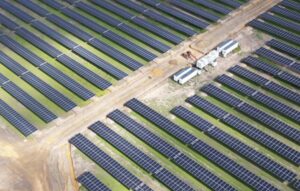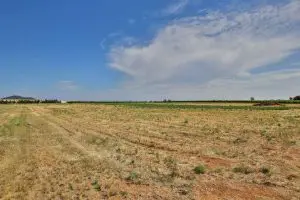Australian software billionaire Mike Cannon-Brookes has teamed up with Tesla and Australian solar company 5B to create a new initiative that will provide stand alone solar and battery storage systems that can provide power to communities cut off by the summer’s bushfires and storms.
The Resilient Energy Collective was unveiled by Cannon-Brookes on Wednesday afternoon, and will be backed by an initial $12 million investment from the Cannon-Brookes family investment fund, and follows his commitment to fund a detailed study into what could become the world’s biggest solar farm in the Northern Territory.
Cannon-Brookes says many areas affected by the bushfires still don’t have power, and while the collective has already rolled out solar and batteries in two fire-ravaged locations – in Cobargo in NSW and Goongerah in Victoria’s East Gippsland region – it has the capacity to roll out systems at another 100 sites “in the next 100 days if required.”
“Solar and batteries are resilient,” Cannon Brookes said in a statement. “They are an awesome off-grid solution that are quick and easy to transport and deploy.
He told Reneweconomy that the reaction from the people in the communities had been amazing. Many had thought such technologies were 10 years away.
“They said, ‘does this run at night?’ Yes! They said, man, this is technology from the future. No it’s not, it’s stuff that you find on the shelves. The only new bits we added were nuts and bolts from Bunnings.”
Cannon-Brookes said that after a horror summer, “many Aussies need our help to get their lives back on track. We’ve got to do all we can to get them back on their feet.
“In three weeks we’ve come together, found the technology, adapted it, put it on trucks and right now it’s operating, generating electricity. That’s what this collective is all about; getting the best tech and the best ingenuity together to solve a massive problem, in days, not months or years.”
The joint venture with Tesla rekindles Cannon-Brookes’ links with the company co-founded and led by CEO Elon Musk. Their Twitter exchange in early 2017 supercharged efforts to bring a big battery to South Australia, and the world’s biggest lithium-ion battery was ultimately installed in less than 100 days after contracts were signed, as Musk had promised.
Cannon-Brookes has also been working with 5B, a company founded by a couple of young engineers that specialises in readily and rapidly deployable solar installations, for the massive 10GW Sun Cable solar project in the Northern Territory where it has been named preferred supplier.
“I know Tesla from way back, done some batteries before, and I know 5B from Sun Cable and through the climate accelerator program,” Cannon-Brookes told RenewEconomy.
The Resilient Energy Collective says the rapidly installed solar and battery solutions – with can range in daily capacity from 8kWh to 400kWh – can allow infrastructure, homes and businesses to operate off-grid, 24 hours a day.
It says it is working with energy providers to identify and target the most urgent sites across NSW, Victoria and South Australia, many of which are currently dependent on noisy, dirty and expensive diesel generation.
There is also a view to creating new and resilient off grid energy solutions, and this initiative is also looking at providing the means for households and communities to move off generator power, and set up more resilient solar/battery solutions – well before poles and wires can be reconnected.
The installation at Cobargo comprises a stand alone, off grid solar and battery system has helped to reconnect electricity to vital emergency communications towers. It supplies a police radio tower and an RFS, National Parks and Eurobodalla Shire radio tower.
It was installed and operational in less than two days and replaced diesel generators that firefighters had been needed to constantly refuel, taking one of the local area’s four firefighters up to five hours a day and keeping them away from the firefront. It now works 24/7 a day.
Another system has been installed to power the Goongerah Community Hall to provide power to relief services, the local internet connection, as well as refrigeration, and important community meetings. Other suppliers to this system included Enfrex Metalworks, Risen Energy (Australia), Southern Precast NSW, DSE Transport and AG MURF Australia.
dir=”ltr”>
“These systems are cheaper than diesel generators and they are up and running months before electricity will be fully restored,” Cannon Brookes says.
“As a nation we’ve got to learn the lessons of this summer and invest in energy systems that help the planet, not hurt it, that are resilient, not brittle, that are fast and flexible, not slow and fixed. And most importantly that reduce bills,” Cannon-Brookes said.
“In the future – we see a world in which many remote communities operate on solar power, off-the-grid. It will be more stable, more resilient, and less prone to damage.”
Network providers and energy utilities have long accepted that renewable based stand alone power systems can offer cheaper, more reliable and cleaner energy solutions to either extending the networks hundreds of kilometres, with all the risks of storms, dust, fires and floods, or local diesel generators.
They admit that they spend thousands of dollars – per kilometre – to maintain power lines traversing large distances to service just a few customers, and that it would be far cheaper to cut that wire and deliver stand alone renewable energy power systems.
It’s already starting to happen in Western Australia, where Western Power and Horizon Energy says thousands of customers could be served that way. Western Power have been talking about this for years.
See: WA looks to solar-storage micro-grids to replace poles and wires after bushfires.
However, most utilities never had the incentive to make that sort of investment, although the market rule-maker has now prepared draft rules that will encourage stand alone system to replace poles and wires, although there are still somer regulatory hurdles that towns and communities who want to pursue that option have to follow.
The emergence of the Resilient Energy Collective, backed by the likes of Cannon-Brookes and his wife, Annie, could kick-start that shift to community renewable micro grids. But Cannon-Brookes says he cannot do it alone.
“To get this done, we need the cooperation of the energy providers – we want to work with them to identify the areas most in need. This is a perfect solution to a massive problem. It will restore power faster. It’s renewable, reliable and clean.”
But he told RenewEconomy that while this was a philanthropic venture, there was likely a business case for standalone power system – the costs were up to 50 per cent cheaper than diesel gen-sets, and cheaper in many circumstances for grid connected communities. And it reinforced that the technologies needed to improve the lives of Australians, and lower costs and emissions, were here now.









